1 Temples and Palaces of Kyoto
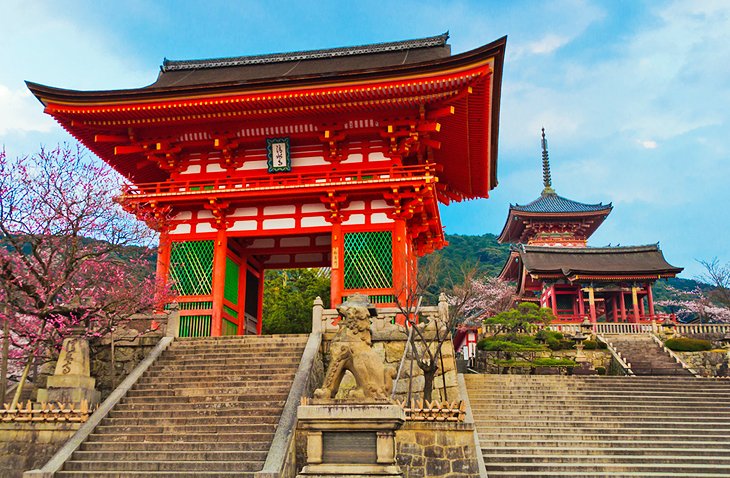
Temples and Palaces of Kyoto
Less than an hour by high-speed rail from Osaka's downtown core, Kyoto boasts enough temples and historic sites to keep you busy until the last train back to your hotel. One of only a handful of major Japanese cities to escape devastation during WWII, Kyoto attracts upwards of 10 million visitors each year, most to explore its magnificent, historic streetscapes, much of which was laid out more than a thousand years ago. In addition to its numerous fine art galleries and museums, Kyoto also has one of the country's highest densities of temples. One of the most famous is Kiyomizu Temple, a UNESCO World Heritage Site perched high up on the Otowa Mountain overlooking the city, accessed by quaint Tea-pot Lane with its small shops and craft stalls. Founded in AD 790, the temple's highlights include the spectacular Main Hall, now used as a stage for temple dances and ceremonies and where you'll find some of the best views over the surrounding area. Other Kyoto attractions of note include the beautiful 14th-century Golden Pavilion, with its exquisite gold leaf exterior; the 17th-century Nijo Castle; and the even older Imperial Palace, built in AD 794.
2 Nara's Big Buddha
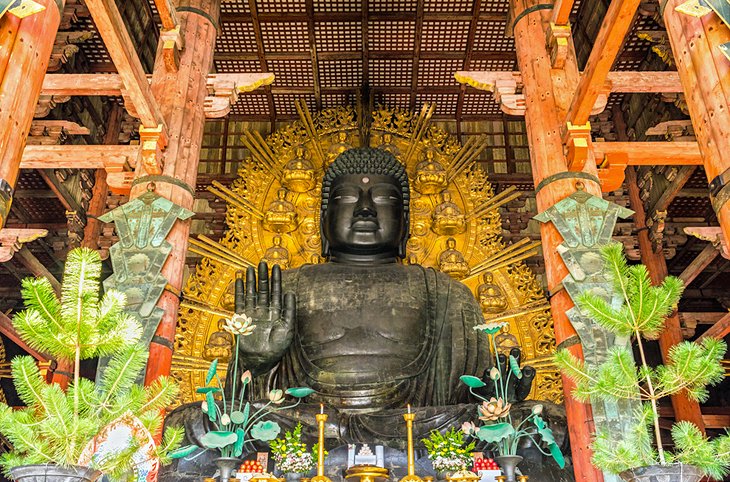
Nara's Big Buddha
Just 40 minutes east of Osaka, the beautiful old city of Nara has long been at the center of Japan's rich cultural heritage. Unspoiled, thanks to being spared the devastations of WWII, this easy-to-explore city boasts numerous fine examples of traditional Japanese architecture, seen everywhere from its many important historic temples and palaces to its humbler homes and workshops dedicated to centuries-old crafts and trades. A definite highlight of a visit is exploring Nara's many old districts on foot, many of which lead to such iconic structures as the magnificent Kofuku-ji Temple, built in the 7th century and famous for its tame deer. Probably the most visited of the Seven Great Temples of Nara, however, is the majestic Todai-ji or Great East Temple. Built in the 8th century, the temple is famous for its large bronze statue of the Great Buddha, Daibutsu, cast nearly 1,300 years ago. Other features of note here include the two-story Great South Gate, supported by 18 columns and guarded by two eight-meter-tall statues.
3 Historic Shirasagi Castle

Historic Shirasagi Castle
A little more than an hour west of Osaka, along the pleasant coastline of the Harima-nada Sea, is the historic city of Himeji. Here, you can easily spend the best part of a day exploring magnificent Shirasagi Castle, the largest fortification in Japan and one of the country's first historic sites to be granted UNESCO World Heritage status. Built in the 14th century and often referred to as White Heron Castle - a nickname given by locals for its white exterior walls, which they claim resemble the outspread wings of a white heron - the attraction consists of some 80 buildings, most of them open to the public. The highlight, however, is the castle's tallest point, the five-story-tall main keep (be sure to make the climb all the way to the top for the amazing views over the city and surrounding countryside). When you're done exploring, spend at least a little time shopping for souvenirs in the many interesting shops at the bottom of the narrow, meandering paths heading up to the castle.
4 Mount Koya
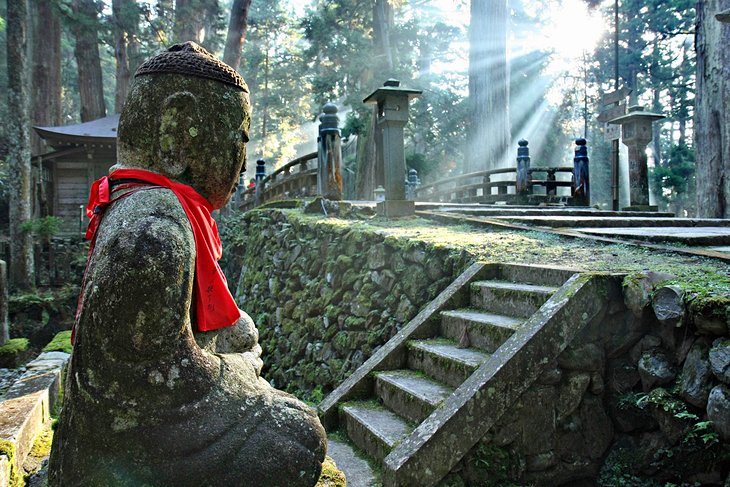
Okunoin Buddhist Cemetery at Mount Koya
A two-hour drive south of Osaka (and one of those rare occasions when a car will get you there faster than public transit) is Mount Koya, also known as Kōyasan. It's a windy route, but one that provides an excellent opportunity to see some of this region's magnificent hill country up close. Once in Mount Koya, you'll be rewarded with an opportunity to explore one of the most important religious sites in Japan, and certainly one of the most extensive. Much of the area is in fact dedicated to a branch of Buddhism known as Shingon, founded in Japan around AD 800, when its founder, Kobo Daishi, built the first small temple here. Today, a substantial town has been built up around this historic site, much of it here to cater to the many pilgrims, who travel from across the country to pay homage at the temples and the grave sites of the many monks buried here, an often colorful display due to the many bright red scarves left as tokens of respect. Expect to spend the best part of a day exploring this picturesque community, with its more than 100 temples and shrines, including the most visited, Kongobuji. With advance planning, visitors can book a night's stay at one of the temples, a unique experience that is highly recommended for adult travelers.
5 Towering above Kobe

Towering above Kobe
An easy 30-minute commute west of Osaka is the major port city of Kobe, the sixth largest city in Japan and a fun place to explore. The best place to start your Kobe adventure is in the city center, home to the first of the city's two towers, the Tsūtenkaku. Built in 1956 to replace a replica of The Eiffel Tower destroyed in WWII, this 103-meter-tall edifice offers excellent views over both Kobe and Osaka Bay. In addition to the views - the best of which is from the observation deck at 91 meters - the tower even boasts its own shrine, this one dedicated, perhaps appropriately for its smiling icon, to the God of Happiness. From here, you'll also catch a glimpse of Kobe's second and newer tower, the architecturally appealing Kobe Port Tower. Standing 108 meters high and notable for its red steel construction, it opened in 1963 and, as its name suggests, overlooks Kobe's bustling port area. It also has an observation deck with superb views over Osaka and Kobe Port and, like its sister tower, is lit up at night.
6 Meiji-mura Village
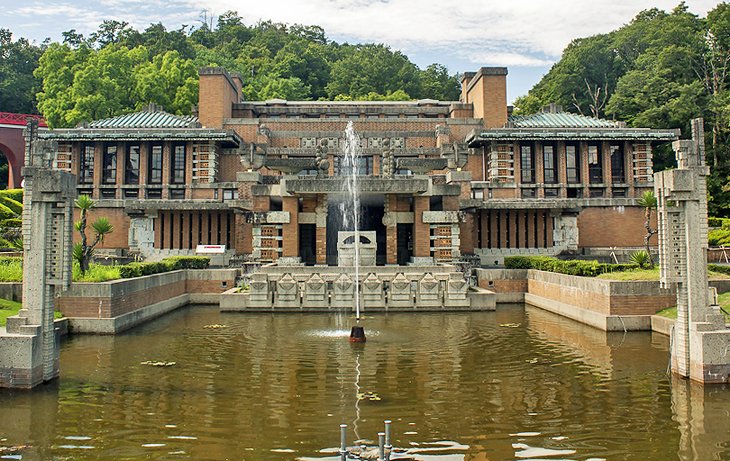
Imperial Hotel at Meiji-mura
About 2.5 hours east of Osaka (and just 24 kilometers north of Nagoya, making it possible to combine these two excellent attractions into a single trip) is Meiji-mura Village Museum, a rewarding day trip for those wanting to learn more about Japan's rich culture and history. In the town of Inuyama, Meiji-mura is almost as much a theme park as it is an open-air museum, and offers many fun and educational experiences. Highlights include its numerous well-preserved buildings dating back to Japan's prosperous Meiji period from 1868 to 1912. The village comprises some 60 or more buildings relocated here from across the country, and a stroll through its streets can take a few hours, so be prepared to take your time. Particular highlights include a visit to an original post office, a former palace, a bathhouse, and even a prison. Of particular interest to many visitors is the influence western architecture had upon the design of so many buildings from this period, most noticeably in the old Imperial Hotel designed by American architect Frank Lloyd Wright. A highlight for kids is a chance to ride on preserved trams, buses, and even a streetcar from this important period of Japanese history.
Address: Inuyama, Aichi Prefecture 484-0000
Official site: www.meijimura.com/english
7 Nagoya
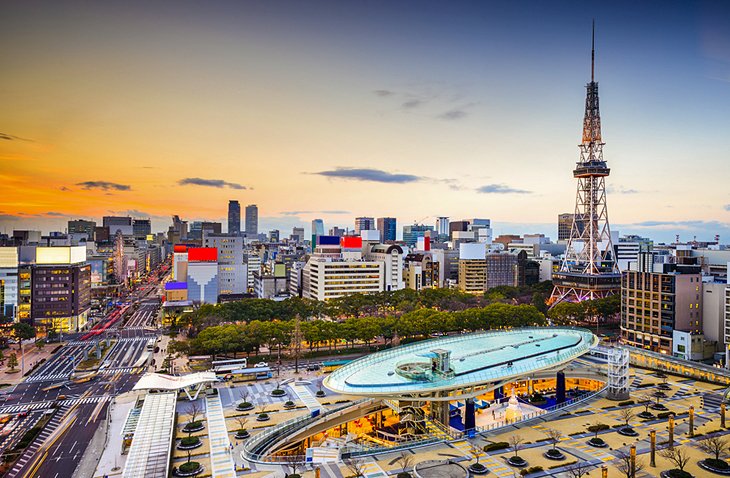
Nagoya
A two-hour journey by rail northeast of Osaka is the busy port city of Nagoya. Owing to its access to the Pacific Ocean, Nagoya is the busiest port in Japan and is known across the country for its many traditional industries, in particular those focused on ceramics and textiles, which have been around for more than 900 years. A variety of tours are available to these factories and workshops, each of which offers a unique view into both past and present manufacturing methods. Other highlights of a visit include a trip around the city's lovely 6th-century castle, as popular for its huge main tower as it is for its expansive gardens. It's also a city of many well-preserved temples, one of the nicest of which is the Atsuta Shrine. Tracing its roots as far back as the 1st century, this splendid Shinto temple has long held an important place in the country's culture due to its connection to Japanese royalty (be sure to ask your tour guide to point out the royal insignia found here, one of only three locations in the country where this emblem has survived).
8 Hiroshima's Shrine Island

Hiroshima's Shrine Island
Just under three hours west of Osaka by high-speed train - long enough to enjoy one of Japan's greatest inventions, the always-fresh Bento quick meal - is historic Hiroshima. The city has numerous sites dedicated to that fateful day in August 1945, when it was devastated by the world's first nuclear attack, including attractions such as Hiroshima Peace Memorial Park, which is home to the Peace Memorial Museum, the famous Memorial Cenotaph with its Flame of Peace, and the Atom Bomb Dome. One of the must-sees is Hiroshima Castle, built in 1593 and home to an excellent museum dealing with the region's rich history. Of the city's many temples, the best known and most popular is the Itsukushima Shrine, located a pleasant ferry trip across Hiroshima Bay on Shrine Island (Miyajima). Be prepared to spend the best part of a day here exploring the temple's many buildings, the majority built over water and connected by bridges. (Hot Tip: Try to time your visit to coincide with one of the temple's many festivals or traditional dance events.)

No comments:
Post a Comment